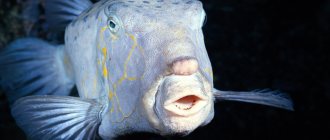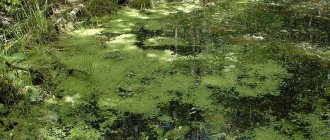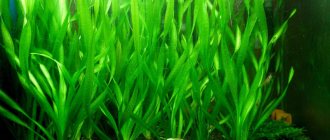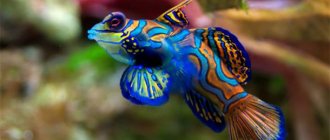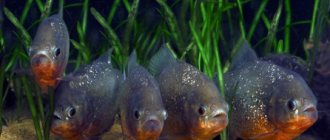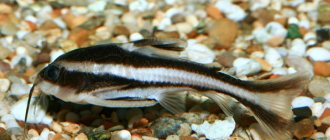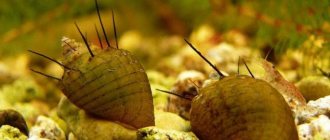In nature, there are many fish without bright colors, which allows them to successfully hunt or hide from predators. But dull and gray inhabitants are unlikely to decorate an aquarium. That is why breeders have been selecting and preserving the most striking representatives with an unusual body shape and fins for decades. And we have achieved significant success in this. Selective breeding has allowed modern aquarists to choose their pets from a wide variety of colors and shapes. In this article we will tell you about the most beautiful aquarium fish , so that everyone can decide who to put in the aquarium based on their own preferences.
The most beautiful aquarium fish
On a note ! Each fish is beautiful in its own way, but we still managed to make a rating of the TOP 20 most attractive, in our opinion, inhabitants of the aquarium.
Handsome Chromis
Handsome Chromis
This fish is a real pearl among African cichlids. In many countries it is also called the “jewel cichlid.” The body color of the fish is really gorgeous! Her body is bright red, with many bluish-green dots scattered throughout it, shimmering in the reflected light no worse than precious stones. In suitable conditions, chromis can grow up to 15 cm in length. The optimal volume of an aquarium for a pair of fish is at least 60 liters. As for compatibility, Chromis has problems with it: his character, to put it mildly, is not sweet, there is a pronounced territoriality .
Cichlasoma severum
This fish is found in all freshwater bodies of northern South America. In the scientific world, cichlazoma received a new Latin name Heros severus.
Pink and brown spots create a bizarre pattern on the fish’s body. The cichlazoma itself has a different color: from light yellow and greenish to dark brown.
The peace-loving fish shows aggression only during the spawning period and while caring for the offspring.
13
Frontosa
Frontosa
Frontosa is one of the most charming cichlids of Lake Tanganyika. The body length can reach 30 cm, and therefore the volume of the aquarium for keeping must be at least 300 liters. The frontosa has a large and massive body, and a fatty growth is located above the head (in males it is larger). But the most attractive thing is the stunning coloring, which is an alternation of wide dark and light stripes. There are several geographical species , differing in color intensity, location and number of stripes.
Note ! Frontoz's neighbors in the aquarium should only be comparable species of fish, since everything that fits into the mouth will most likely be eaten.
Catfish
Catfish are the hardiest and most unpretentious fish species, which makes them excellent candidates for home aquariums. The creatures eat almost everything, are peaceful, and are not picky about their living conditions. The only disadvantage of breeding is the possible rapid growth and enormous size of catfish, which require very large aquariums. All species of bottom-dwelling catfish have hard spines on their bodies, so they must be handled with care.
Below you can see a list of catfish names for an aquarium with photos:
- Agamix White-spotted;
- Ancistrus vulgaris;
- Arius Zimana;
- Hypancistrus Zebra;
- Corridors;
- Loricaria Red;
- Tarakatum.
Princess of Burundi
Princess of Burundi
Princess of Burundi (another name is Neolamprologus Brishara) lives in the waters of Lake Tanganyika in Africa. It was not by chance that this peace-loving fish was named princess. It has a very elegant elongated body, a lyre-shaped tail and veil fins with pointed tips. The body size does not exceed 10 cm. To keep a group of neolamprologus, you need an aquarium with a volume of 130 liters or more.
The Princess of Burundi's coloring may seem modest, but if you look closely, you'll notice some interesting details. The scales of the fish are pinkish-white, with yellow speckles. The mosaic pattern at the bottom of the head has a blue tint, and a black stripe runs from the gill cover to the edge of the eyes. Another feature is the blue edging of all fins.
Reproduction and lifespan
Grown-up fish are ready for spawning at the age of one year with a body length of 3-4 cm. Reproduction efficiency is higher in mature thornets, but you can also choose young, sexually mature caramels. Preparation begins with the placement of the selected pair and abundant feeding of the fish with live food.
A special container of 30 liters or more is prepared for spawning. The place for the aquarium should be with diffused, dim, soft light. Twilight is suitable, which can be created with sheets of paper covering the illuminated glass of an artificial pond.
For the spawning ground, dark soil, small-leaved plants, and soft acidic water are selected. For arrangement, it is good to place water moss on the bottom of the aquarium. It is recommended to maintain the water level at 7-8 cm, with a temperature of 24-25°C.
A filter is required in the container, and a thermostat is required to maintain the desired temperature. The water is left to settle for several days before filling the spawning area. It must be saturated with oxygen and contain tannins.
To do this, you can add a little boiled water to distilled water after settling, add peat extract with an acidic reaction, add willow roots and alder cones. An extract option is oak bark or weak tea.
After the fish settle in, 3-6 days later the active movement of the pair begins. The reproduction of thorns can be observed in the early morning. The male chases the female around the pond with short breaks.
The female lays hundreds of sticky eggs in small portions of up to 30 pieces. They settle on algae leaves and decorative parts of the aquarium. The male fertilizes the eggs with milt.
Spawning time lasts up to 3 hours. The total number of eggs spawned and fertilized reaches a thousand or more. Experienced aquarists note this high figure in comparison with other types of fish.
After completing the process, it is necessary to transfer the parent pair to another container so that the eggs and future fry do not end up being eaten. The mesh located at the bottom of the aquarium additionally protects the offspring from destruction.
An aquarium with thorns looks very bright and colorful
It takes about 2 days for the larvae to hatch. The water in the container should be heated to 27-28°C. Barely noticeable living crumbs stick to plants and the walls of the reservoir, and only on the third day do they begin to swim independently.
It is noteworthy that the spawning of thornets is active and does not cause problems, but the fry appear quite weak and very small in size. Initial feeding of baby ternets is carried out only with the smallest feeds. They include ground living dust, consisting, for example, of rotifers. Swimming fry can be fed with boiled yolk.
Not all fry survive; mass deaths occur. Growing individuals need to be gradually transferred to daphnia moina, small bloodworms, cut coretra - larger foods. Hungry juveniles are first fed dry and artificial additives, and then given their usual food.
It is important for owners to monitor the condition of dry food: check the date of manufacture, shelf life, and do not store it open to prevent the development of pathogenic flora. During the period of growth, fry need to be sorted by size: large and active ones must be eliminated, giving small individuals a chance to survive.
Ternetia fish
In general, the health of thornets is good. The fish adapt well to various environments with fluctuations in acidity, hardness, and water temperature. Colored caramels are somewhat weaker than their relatives, but there are no particularities in the maintenance and treatment of these beauties. The advice of experienced aquarists applies to thornets of all types.
Disease prevention is as follows:
- increase in reservoir temperature to 30°C;
- salt baths;
- the use of antiseptics - trypaflavin or others.
A caring attitude towards aquatic inhabitants will preserve their lifespan up to 4-5 years; especially strong ones can live up to 6 years.
Cockerel
Cockerels
A distinctive feature of Siamese cockerels is not only their quarrelsome temperament, but also their excellent appearance. The body size is on average 5 cm, but if you add the size of the fins of some breeds, the figure can be doubled. Breeders have bred over 70 breeds of cockerels, which differ in color and shape of fins. There are white, pink, red, blue, emerald, and black specimens on sale.
According to the shape of the cockerel's tail, there are:
- deltatails;
- crown-tailed;
- double-tailed, etc.
On a note ! It turns out that everyone can choose a fish to their liking. It is better to keep males alone or in the company of a female. The volume of the aquarium is at least 20 liters.
Unusual fish
Every owner of an aquarium wants to fill it not only with standard fish, but also with aquatic inhabitants of unusual breeds, similar to fairy-tale creatures. This category includes fish that have exotic characteristic features: a non-standard body structure or bright colors. Such pets have an increased price and also require special feeding.
Decorative amazing aquarium inhabitants include:
- Aravana;
- Tetradon green;
- Tishrov perch;
- Lala Glass Perch;
- Glass Angel;
- Splash fish;
- Argus fish;
- Elephant fish;
- Swallow fish;
- Freshwater moray eel;
- Carapace;
- Imperial minnow.
Nothobranchius
Nothobranchius
Among the spawning carp-toothed fish there are very beautiful fish, the body color of which resembles the pattern of orchid flowers. The life cycle of the African species of Nothobranchius is closely related to the rainy and dry seasons. With the onset of the rainy season, these fish emerge from eggs , and then, quickly reaching sexual maturity, spawn until the very beginning of the drought. Moreover, the eggs can be in the hibernation stage for up to 6 months. Therefore, the life of nothobranchius is very short, despite even being kept at home. However, the fish are still very popular due to their stunning colors.
Characinaceae
Among this group there are true predators or vegetarians, microscopic individuals or giants, as well as extremely peaceful or very aggressive species. Almost all representatives have the adipose fin characteristic of this group. These fish have been bred in an artificial environment for several decades, so they are well adapted for keeping at home.
Below you can find a description of the names and photos of the most beautiful characin fish:
- Carnegiell;
- Neon;
- Nannostomus;
- Pink Tetra;
- Rhodostomus;
- Glass tetra;
- Philomena;
- Erythrosomus.
Red neon
Red Neon
Red Neons are often found in aquascapes , as these small fish are the most beautiful representatives of the Characin family. The peculiarity of red neons is 2 red stripes running along the entire body (one is bright red and the other is blue, with a characteristic neon glow).
The body size does not exceed 5 cm. The fish are kept in schools, and the larger the group, the better it looks. Neons get along well with peace-loving fish and living plants.
Pantodon
Lovers of the extraordinary will want to have this fish in their aquarium. She is recognized as a long-liver and, according to some sources, could outlive dinosaurs. Natural habitat - Africa. And its feature that distinguishes it from other fish is the ability to fly above water.
Like other African inhabitants, Pantodon is very capricious. If he doesn’t like something, he will get sick and may even die. Separately, it is worth considering its nutrition. The pantodon's diet should contain fresh (live) beetles and flies.
aquass.ru
Nannakara neon
Neon Nannakara
A very unusual fish, the appearance of which is still not known for sure. According to experts, this is a hybrid , the result of crossing some American cichlids.
If you take a closer look at Nannakara, it will immediately become clear why it is so popular among aquarists. The fish has bright blue scales with a golden-pearl sheen. A well-developed dorsal fin stretches from the tail to the head and has a yellow edging on top. The body size is on average 13 cm, the required aquarium volume for a couple is from 100 liters. Nannakars are quite peaceful and hardy.
Tiger catfish merodontodus
The natural habitat of this rare flathead is the cascades of river rapids in the Rio Madeira, Brazil's great waterway. Merodontus are quite large in size. In nature, they reach a length of 70-75 cm and to keep them in captivity they need large volumes of water and a powerful watercourse system.
Tiger catfish are distinguished by their bright, silver color with contrasting stripes, forming unique patterns in each individual. On the flat, large head there are 3 pairs of long whiskers, which also attracts some aquarists. It is quite difficult to catch exotic fish from the rocks of the waterfall; moreover, the export of rare fish is prohibited by law and violators are severely punished. World prices for exclusive catfish are about 1.5 thousand dollars.
Macropod
Macropod
One of the first aquarium fish to become widespread due to its beautiful appearance and good endurance was macropods. They grow up to 10 cm, have an elongated body and developed unpaired fins. The length of the lyre-shaped caudal fin can reach 3 cm. The color deserves special attention: the body is olive or blue with many transverse stripes.
On a note ! The volume of the aquarium for macropods is from 40 liters. The fish has a fighting character; it gets along with a limited number of species (especially in a small aquarium).
Cichlids
The cichlid family are beautiful, flat and active aquarium inhabitants. The number of species ranges from 2 to 3 thousand. Individuals in most cases belong to territorial species. They are distinguished by aggressive behavior towards other fish, but are caring parents. They easily recognize their owners and love to beg for food.
Among the most beautiful representatives are noted:
- Akara Turquoise;
- Blue dolphin;
- Yellow, redmouth and Cichlid;
- Flat angelfish Koi;
- Jaguar Cichlid.
Magnificent colors, extraordinary behavior and relative ease of maintenance have determined the success of these fish among aquarists around the world.
Lyalius
Lalius
A small labyrinth fish that can decorate any tropical aquarium. Lalius clearly exhibits sexual dimorphism: females are of no value in terms of beauty (like most other species), but males will never be left without attention. Their silver body is covered with red and blue luminous stripes (although there are breeding forms with other color options). Over the course of evolution, the pectoral fins have become thin, sensitive filaments .
The body size of the lalius is 6-7.5 cm. A large aquarium is not needed - 40 liters is enough. Lalius are compatible with most ornamental fish of the same size.
Astatotilapia burtoni
One of the species of ray-finned fish with a very original body color. They are mostly found with a gray or reddish-yellow color, but the sides have a blue, green or purple sheen.
Fish can be kept in an aquarium with other similar fish, but it is necessary to provide shelters for the females. Males of Astatotilapia burtoni, except during the spawning period, behave aggressively.
2
Discus
Discus
Discus are unusual South American cichlids that are distinguished primarily by their round shape and many color variations. These fish first appeared in aquariums in the middle of the last century. It is difficult to keep them, however, the variety of breeding forms is simply eye-opening!
On a note ! Discus fish behave imposingly, like aristocrats, and therefore they are also called “kings of the aquarium.” The body length reaches 25-30 cm. They are kept in schools in aquariums with a volume of 400 liters or more. Discus fish are not very hardy; they are very sensitive to feeding and water parameters.
Arowanas
These dragon fish are the oldest representatives of the water kingdom. Under natural conditions, they can be found in the fresh waters of the South American and African continents, as well as in the reservoirs of southeast Asia. The fish have a calm, easy-going character. They have the rudiments of intelligence: they quickly get used to their owner and take food from his hands.
Arowanas are large fish and to keep them you need a large displacement aquarium (optimally up to 1000 liters), equipped with an opaque lid. Under natural conditions, fish jump 1.5-2.5 m out of the water after flying insects and even small birds. There are 3 popular varieties of arowana - silver, pearl and platinum. The first two types are more “affordable” in price; the cost of one copy ranges from 50 to 200 thousand rubles. The platinum arowana is the rarest and most expensive type, its price reaches 400 thousand dollars.
Pearl gourami
Pearl gourami
One of the most beautiful aquarium fish. Gourami has a silvery-purple body with numerous small spots resembling pearls. During spawning, the fish literally burn! Modified pelvic fins, resembling long sensitive threads, help the fish explore the world around them.
The body size of pearl gourami reaches 12 cm. The fish do not need forced aeration , because they can breathe atmospheric air (you just need to provide access to the surface).
Panak
This genus of distinctive and original catfish includes 14 species that have some similarities. Outwardly, these catfish resemble their ancestors - in the mouth of the individuals there is a special working organ - a scraper, using which the fish remove plaque from various surfaces. With the help of powerful suction cups, panakas attach to driftwood, hanging with their backs down, and can remain in this position for a long time.
When arranging a tank, especially the bottom area, you should carefully choose the decor - catfish often get stuck in narrow passages and die. You can choose fish of the same size as neighbors - the panak will not dare to attack such a large individual.
Guppy
Guppy
Guppy is the most famous aquarium fish, which does not lose popularity, despite its small size and long history. This is explained, first of all, by the unpretentiousness of guppies, ease of reproduction and a wide variety of colors.
It is difficult to count the number of breeding forms of guppies. There are varieties that differ in the color of the body and caudal fin. The shape of the tail also varies.
Leopoldi's stingray (Potamotrygon Leopoldi)
This original fish looks great in display aquariums, and, despite its high cost, is very popular among collectors around the world.
The bottom of the aquarium must be cleared of vegetation and decorative elements so that the stingrays can move freely.
This is a bottom-dwelling fish, so it is necessary to take this feature into account when feeding. The food should sink and then the fish can easily pick it up from the bottom.
14
Glofish
Glofish
Glofish is the result of the efforts of genetic engineers. The genes of marine coelenterates are introduced into the DNA of the fish, due to which some species have the ability to fluoresce, i.e., biological luminescence. Under an ultraviolet or blue lamp, the glowfish flashes like a neon advertisement. Although the fish have an unusual bright color even without special lighting.
Keeping genetically modified fish is no different from keeping conventional species. In addition, fluorescent genes are passed on hereditarily, and all subsequent generations will also “glow.”
Types of thorns
Caramels of various colors are obtained by injection with a coloring solution. External intervention allows you to achieve bizarre results, which are of interest not only to amateurs, but also to professionals.
Ternetia veil
Chemical exposure weakens the thornets' body, but does not change their biological characteristics, behavioral characteristics, or care for them. The main popular colors of fish:
- pink;
- blue;
- yellow;
- violet;
- green.
Fashion trends in the aquarium hobby are leading to the widespread proliferation of exotic caramels. Schooling fish are bought by at least 7-9 individuals, but the more there are in the group, the better. They occupy a worthy place among other types of thorns:
- classical;
- veil;
- gold;
- albinos.
Ternetia Glofish (GloFish) are modified fish with a fluorescent glow. Ultraviolet lighting makes them even brighter. Unlike caramels, color is inherited.
Ternetia multicolor
Thorn species are created by transgenic technologies using DNA from jellyfish, red corals, and various combinations. The result is forms of green, red, orange, blue, yellow flowers.
Interestingly, the dyeing does not extend the results to the tail or fins. They still remain black or dark green. This feature influenced the second name of the ternation - mourning tetra, since the long fin frames the bottom line of the body, creating a dark outline.
Veiltail
Veiltail
The most beautiful breed of goldfish. The main feature is thin long fins that resemble a veil. The body is spherical or egg-shaped, and the size of the caudal fin can be several times the size of the body. Colors come in a variety of colors.
The maximum size of a veiltail is 20 cm. One fish needs at least 50 liters of water. It is important that there are no decorations with sharp edges in the aquarium, otherwise the fish may damage their gorgeous tails.
Piranhas
It is no coincidence that it is no coincidence that fish that inspire horror, attract attention due to their unusual, pristine appearance and are participants in many horror films and thrillers are included in the list of the most beautiful aquarium inhabitants. Representatives of the breed, although they may seem very unattractive, have original colors.
As for their bloodthirstiness, there is some truth in this; some species are so insatiable that they even try to attack crocodiles. But there are also species that feed exclusively on plant foods or consume no more than 50 g of meat in 2-3 days.
Botia clown
Botsia clown
The bottom fish, botia clown, is a representative of the loach family. The attractive coloring will not leave anyone indifferent: the body is yellow-orange with three black transverse stripes that resemble a wedge tapering towards the belly. Because of this, the fish are also called tiger bots.
In an aquarium, clown bots can grow up to 25 cm. They are kept in groups, and therefore require a fairly large tank. Stay in groups. Lighting should be dim. Clone bots get along well with all sized fish, including aggressive cichlids.
Steatocranus
Another luxurious member of the cichlid family, which is called the lionhead cichlid. Representatives of the breed are distinguished by an external feature - a large fatty bump on the forehead, the shape of which is compared to the head of a lion. But this is not the only feature of steatocranus - the fish have a complex character and original habits.
To novice aquarists, these slow-moving cichlids may seem harmless. However, their sudden movements and agility are a real threat to neighboring individuals. You can encounter the playfulness of pets when fishing them out of the tank; even driving them out of hiding is a difficult task.
Blue Dempsey
Blue Dempsey
A color variation of the popular eight-striped cichlid, one of the most beautiful inhabitants of the aquarium. The fish has a rich blue color with a shimmering effect. Moreover, the brightness may increase as they grow older. Body size does not exceed 20 cm.
Important ! To keep a pair of Blue Dempseys you need an aquarium of at least 150 liters. Fish have a balanced, calm character.
Neptune's grouper
A stunning inhabitant of the coastal waters of the Japanese islands and Fiji, representing the grouper family, it is extremely rare to find on sale. It stands out for its beautiful bright pink color with transverse intense yellow stripes. Juveniles differ from adult fish in a paler, uniformly yellow or orange color.
Neptune's grouper prefers greater depths - from 70 to 200 meters. It is caught exclusively by hand, which involves many difficulties. To raise a fish from the depths, the diver needs to stop often to decompress himself and the caught exotic fish. Transporting grouper also costs a lot. Hence, the price of 6 thousand dollars will not seem so incredible to collectors and aquarium fans.
Afiosemion
Afiosemion
Afiosemion are representatives of spawning carp-toothed fish, better known as killifish. Currently, about 90 species have been described with an unusual variety of colors - from fiery red to sky blue. In nature, these fish live in extreme conditions. Temperature changes, constant changes in water parameters and even complete drying out of reservoirs have made these fish hardy, and their life is inextricably linked with the rainy and dry seasons.
Golden fish
It is impossible to imagine a home aquarium without this crucian carp. Goldfish are not picky about care, and even an inexperienced aquarium owner with a small budget can purchase them. There are more than 120 species of goldfish, whose characteristics are very different from the usual description of the well-known representative. You can see the differences in more detail in the photographs below. These crucian carp are friendly, and the only important condition for the creatures to live is oxygen-rich water.
The catalog of the most beautiful decorative goldfish for the aquarium includes:
- Butterfly;
- Water eyes;
- Veiltail;
- Pearl;
- Pearl with crown;
- Astrologer;
- Phoenix;
- Panda;
- Comet;
- Little Red Riding Hood;
- Lionhead;
- Nymph;
- Pompon;
- Black telescope.
Apistogram of Ramiresi
Apistogramma Ramirezi
A dwarf cichlid native to the South American continent. This small fish grows up to 7 cm in length. The Apistogramma has a peaceful character and gets along well with most tropical fish. One of the main advantages of the apistogram is its color. It seems that nature decided to use all the colors it had on the fish.
Peppermint Angel
A beautiful and rare representative of the pomacanth family lives in the great depths of the Pacific Ocean in the coastal waters of the Cook Islands archipelago. The red and white fish is very small, no more than 7 cm. At the 2012 Hawaiian exhibition, only one pair of mint angels was presented, which immediately gained popularity and recognition from world collectors.
It is very difficult to get a small, nimble fish from a depth of 150 meters; it deftly hides in rocky crevices of underwater reefs. You also need to very carefully deliver it to the surface without causing much harm. Keeping a small exotic requires the creation of special conditions and is quite expensive. The average price of one copy on the world market is about 30 thousand dollars.
Turquoise Akara
Acara turquoise
One of the most beautiful cichlids in South America. Her bluish-green scales seem to be surrounded by a luminous halo. And near the head there are turquoise stripes and spots. The dorsal and anal fins are strongly elongated. A yellow or white edging is clearly visible on them (as well as on the tail). Males often have a fatty growth on their heads. Another name is “green terror”.
On a note ! For maintenance you need an aquarium with a volume of at least 300 liters (if it is a species one). Acara is a territorial fish, unable to get along even with species of similar size.
Angelfish (Pterophyllum)
The Latin name of this beautiful fish comes from two Greek words “wing” and “leaf”. Indeed, the original body shape resembles these two objects.
Keeping angelfish requires a tall aquarium with large-leaved plants. This type of fish holds the record for life expectancy in captivity. Some individuals live up to 10 years.
10
Mr. Tail recommends: universal tips for care and maintenance
Each fish has its own characteristics in nutrition, maintenance and selection of neighbors. Before purchasing, you need to read the description of the desired specimen in order to prepare comfortable living conditions.
There are universal tips that are suitable for caring for any, even the most capricious, individual:
- When purchasing an aquarium, determine the number of fish and the length of their bodies. For every 5 cm, 2 liters are allocated.
- If access to oxygen is not important or it comes through special devices, the container is closed with a lid so that they do not jump out and die.
- A filter is installed to purify the water. After the meal, any remaining food is removed.
- The food is poured in an amount that can be consumed in 5 minutes. Overfeeding leads to health problems.
- Sudden changes in temperature lead to stress in the inhabitants of an artificial reservoir, which negatively affects their condition.
- The aquarium is installed in a place where noise from the environment cannot affect its inhabitants.
- Beginners in aquarium keeping should not start with keeping difficult to care for, large and predatory fish species.
Aravana
Aravana is a fish characterized by a laterally flattened body up to 120 cm long, large shiny scales and a large upward-pointing mouth. Natural color is silver; Breeders have developed many color morphs: golden, red, purple, etc. The cost of the arawana depends on the color. Thus, the most expensive aquarium fish in the world - the platinum arawana - is distinguished by its pure white color and is estimated at 30 million rubles. The best of the red Aravans cost from 3.7 million rubles, more mediocre golden and red specimens cost 30-90 thousand rubles. Aravans of natural color are much cheaper: a fry can be bought for 2,000 rubles, a juvenile - for 5,000 rubles.
Great representatives of the water world
The aquarium with a volume of more than 300 liters is a real treasure. It is possible to recreate a closed ecosystem from any underwater paradise. The following species are in demand among huge fish:
- Pterygoplichthus is an orderly among sucker fish. It has an attractive tiger color; the size of an adult in captivity does not exceed 30 cm. It gets along peacefully with small fish swimming in the middle and upper layers.
- Arowana is a fish with an oblong body up to 70 cm in length and rich color. It hunts insects by jumping out of the water, so it can be bred in an aquarium with fresh water of 600 liters or more.
- Koi carp is a Japanese ornamental fish that reaches 70 cm in length. For comfortable maintenance, a capacity of 800 liters is required. It has a silver body with bright red spots. Shubunkins, comets, discus fish are ideal neighbors for a predator.
This fish reaches 70 cm in length
Large fish are attracted not only by their size, they can have a variegated color and an unusual shape. You can rarely find them at home; they are mainly kept in office and exhibition premises.
Orinoco or red-tailed catfish
This is a large resident of the aquarium and requires a capacity of about 500 liters. The size of the catfish reaches 60 cm. It is loved by aquarists for its ability to contact people and eat food from their hands, and allows itself to be stroked. It has a blue body with a white belly and a red tail.
The fish protects its territory and perceives other inhabitants as food, so it is advisable to house it alone or with members of the family. It is not capable of reproducing in an aquarium, so the price per individual is high. It is not advisable to place stones at the bottom, as the blow of the tail can cause them to fly off and break the glass.
Red-striped Mastacembelus
This is a serpentine-shaped predatory fish, reaching 50 cm in length and 8 cm in width. Attracts with bright red stripes on a dark gray body and the ability to communicate with the owner. Gradually, he can be accustomed to hand feeding; his favorite treat is aquarium shrimp.
It should be kept in aquariums larger than 300 liters, and it is advisable to place artificial plants, since the fish tends to burrow into the roots. It is undesirable to breed more than one individual - intraspecific aggression will not allow peaceful coexistence. It should be placed with large moving fish. Care should be taken when cleaning the aquarium, as the spines on the back of Mastacembelus secrete a toxic liquid.
The beauty of the underwater world amazes with its splendor and diversity, and beautiful decorative fish for the aquarium give their owners joy and tranquility. The painstaking work of scientists allows you to choose from a variety of hybrids a species that is suitable in size and color.
The price of thorns
Ternetias are widespread and can be found in any pet supply store or purchased online. Buying caramels is more expensive than buying ordinary thorns, ranging from 100-130 rubles.
The price depends on color preferences, order volume, age and condition of the fish. Pink thornia is very popular . Bright caramel delights lovers and delights children with its appearance.
No matter how much you have to pay for live fish, the real price is measured not by banknotes, but by genuine interest in the unusual world of the inhabitants of foreign rivers. It is human nature to conduct experiments and transform the world— the thorns in the photo are proof of this. The purchase of fish obliges the aquarist to treat the small and fragile life of caramels with care and attention.
